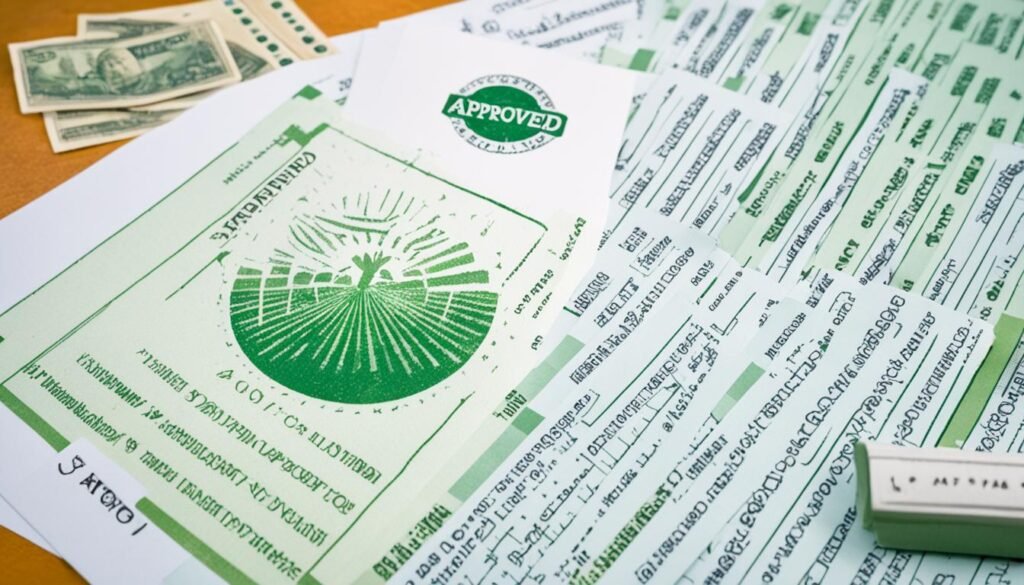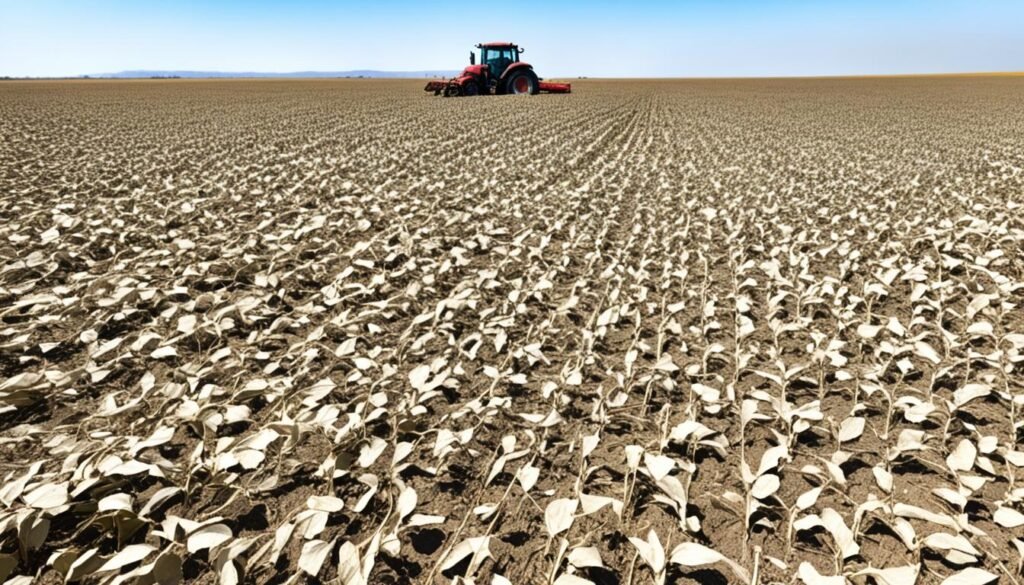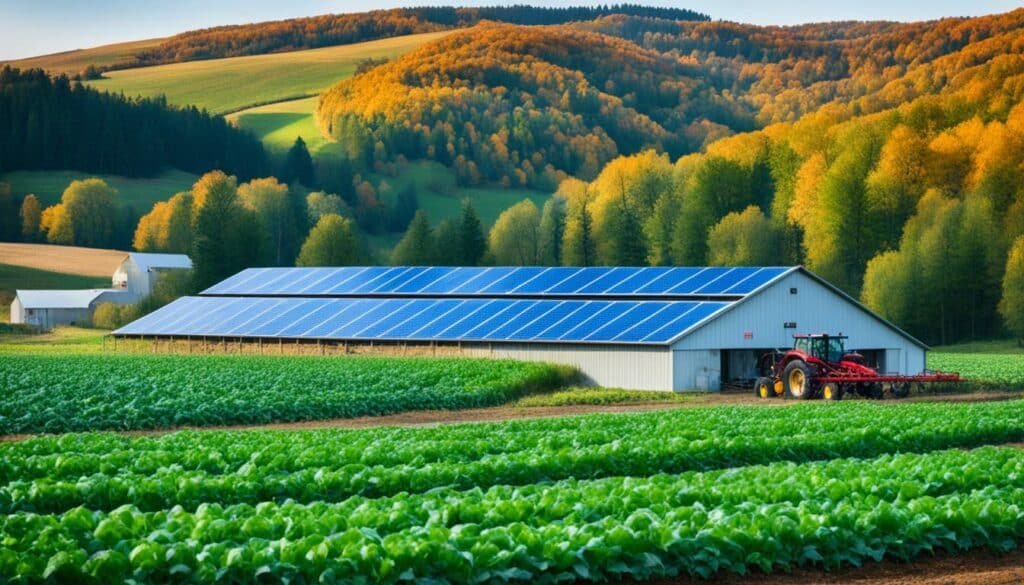Welcome to our comprehensive step-by-step guide on navigating the agricultural loan application process. As farmers and ranchers, securing a farm loan can be a crucial step in realizing your agricultural goals and expanding your operations. However, the application process can often be overwhelming. That’s why we’re here to provide you with valuable insights and tips for successfully navigating the loan journey from start to finish.
Whether you’re a seasoned farmer or just starting out, understanding the ins and outs of the agricultural loan application process is essential. From gathering the necessary documentation to selecting the right lender, applying for a farm loan requires careful preparation and attention to detail.
Throughout this guide, we will walk you through each step of the process, highlight important considerations, and provide expert advice to increase your chances of loan approval and a smooth loan closing. By the end, you will have the knowledge and confidence to navigate the agricultural loan application process with ease and secure the financing you need to fuel your agricultural endeavors.
Key Takeaways:
- Preparing for the farm loan application by gathering necessary documentation and improving your credit score can enhance your chances of loan approval.
- Choosing the right agriculture lender involves considering loan amounts, interest rates, eligibility requirements, and customer service.
- The farm loan application process includes steps such as initial inquiry, application submission, assessment, approval, and acceptance.
- After approval, carefully review the loan terms and conditions before accepting and receiving the loan disbursement.
- Managing loan repayment involves budgeting, setting up automatic payments, and communicating with your lender if facing financial difficulties.
Step 1: Preparing for the Farm Loan Application
Before applying for a farm loan, thorough preparation is essential to increase your chances of loan approval. Gathering the necessary documentation and improving your credit score are critical steps in the process.
1. Collect Financial Records
When applying for a farm loan, lenders will require detailed financial records to assess your financial stability. These documents may include:
- Income statements: Provide proof of your income and revenue generated from your agricultural activities.
- Tax returns: Submit your latest tax returns, including both personal and business taxes.
- Balance sheets: Present an overview of your assets, liabilities, and equity.
Remember to organize and keep these records up to date to ensure a smooth loan application process.
2. Prepare Proof of Income
Alongside your financial records, having solid proof of income is crucial for loan applications. This may include:
- Pay stubs: Provide recent pay stubs if you have a part-time job or another source of income aside from your agricultural activities.
- Bank statements: Show regular deposits and income from your agricultural operations.
Proof of income helps lenders evaluate your ability to repay the loan and increases your credibility as a borrower.
3. Develop a Business Plan
A well-crafted business plan demonstrates your vision and strategy. It should outline your goals, products/services, marketing strategies, financial projections, and more. A robust business plan assures lenders of your professionalism and commitment to success.
4. Assess and Improve Your Credit Score
Your credit score plays a vital role in loan approval. Lenders rely on your credit history to evaluate your trustworthiness as a borrower. Take the following steps to improve your creditworthiness:
- Check your credit report: Obtain a copy of your credit report and review it for errors or discrepancies.
- Pay bills on time: Make timely payments for all your outstanding debts to showcase responsible financial behavior.
- Reduce debt: Paying off existing debts reduces your debt-to-income ratio and improves your creditworthiness.
- Limit new credit applications: Avoid making multiple credit inquiries, as these can negatively affect your credit score.
“Preparing all necessary documents and improving your credit score before applying for a farm loan significantly increases your chances of loan approval. Providing comprehensive financial records, proof of income, and a well-developed business plan demonstrates your commitment and professionalism to lenders.”
Step 2: Choosing the Right Agriculture Lender
When it comes to the agricultural loan application process, choosing the right agriculture lender is a crucial decision. The lender you select can have a significant impact on the success of your loan application and your overall borrowing experience. Here are some factors to consider when choosing an agriculture lender:
- Loan Amount: Determine the loan amount you need for your agricultural needs. Different lenders may offer varying loan limits, so it’s essential to find one that can accommodate your financial requirements.
- Interest Rates: Compare interest rates offered by different lenders. Even a small variation can have a substantial impact on your loan repayment over time. Look for a lender that provides competitive rates to ensure you’re getting the best deal.
- Eligibility Requirements: Familiarize yourself with the eligibility requirements set by the lenders. Each lender may have different criteria for granting loans to agricultural borrowers. Ensure you meet the requirements before applying to increase your chances of approval.
- Customer Service: Consider the level of customer service provided by the lenders. Good customer service can make the loan application process smoother and more enjoyable. Look for lenders that prioritize excellent customer service and offer support throughout the application process.
By carefully evaluating these factors, you can select an agriculture lender that aligns with your loan amount needs, offers competitive interest rates, has reasonable eligibility requirements, and provides top-notch customer service. Choosing the right lender sets the foundation for a successful loan application and a positive borrowing experience.
Benefits of Choosing the Right Agriculture Lender
Choosing the right agriculture lender offers several benefits. Let’s take a look at some advantages:
- Higher chances of loan approval: When you choose a lender that meets your financial requirements and eligibility criteria, your chances of loan approval increase.
- Favorable loan terms: Selecting a lender with competitive interest rates and flexible loan terms can result in more favorable borrowing terms, such as lower monthly payments or longer repayment periods.
- Improved customer service experience: Lenders that prioritize customer service can provide guidance and support throughout the loan application process, making it a smoother and stress-free experience.
- Access to additional resources: Some agriculture lenders offer additional resources and support, such as financial planning tools or educational materials, to help borrowers succeed in their agricultural endeavors.
Choosing the right agriculture lender is an important step in the farm loan application process. By considering loan amount, interest rates, eligibility requirements, and customer service, you can make an informed decision that aligns with your financial goals and maximizes your chances of loan approval.
Step 3: The Farm Loan Application Process
The farm loan application process can sometimes seem daunting, but with the right approach and preparation, it can be successfully navigated. This step-by-step guide will walk you through the key stages, from the initial inquiry to loan approval and acceptance.
- Initial Inquiry: The first step in the loan application process is to reach out to potential lenders and gather information about their loan programs. This initial inquiry allows you to understand the eligibility requirements, loan terms, and application process. It’s essential to ask questions and clarify any doubts before proceeding with the application.
- Application Submission: Once you have identified the lender that best suits your needs, it’s time to submit your loan application. This involves completing the necessary forms, providing documentation to support your financial situation, and demonstrating your ability to repay the loan. Accuracy and completeness are crucial during this stage to ensure a smooth assessment process.
- Assessment: After submitting your application, the lender will review your financial information, credit history, and collateral (if applicable) to assess your creditworthiness. This assessment helps the lender evaluate the risk associated with approving the loan. The lender may request additional documentation or clarification during this stage.
- Loan Approval: Once the lender completes the assessment process and determines that you meet their loan criteria, they will notify you of the loan approval. This stage is a milestone in the application process and an indication that the lender is willing to grant you the loan. At this point, you may receive a formal offer outlining the terms and conditions.
- Acceptance: After receiving the loan approval, it’s important to carefully review the terms and conditions outlined in the offer. These may include the loan amount, interest rate, repayment period, and any applicable fees. If you are satisfied with the terms, you can accept the loan offer, either by signing and returning the documents or following the lender’s instructions. Acceptance is the final step before the loan disbursement.
Remember, each step of the farm loan application process requires attention to detail and understanding of the lender’s requirements. By being proactive, well-prepared, and responsive to any requests or inquiries from the lender, you can increase your chances of a successful loan application.

Having a clear understanding of the farm loan application process is crucial for farmers and ranchers seeking financial support. By diligently following each step, from the initial inquiry to loan approval and acceptance, you can navigate the process with confidence and increase your chances of securing the funding you need.
Step 4: Farm Loan Approval and Disbursement
Once you’ve submitted your farm loan application, it will go through a thorough assessment and underwriting process. This stage is crucial for determining whether your loan is approved or not. The lender will carefully evaluate your financial documents, credit history, and collateral to assess your eligibility for the loan.
After the assessment, if your loan application is approved, you will receive an offer letter from the lender. This letter will outline the loan terms and conditions, including the loan amount, interest rate, repayment schedule, and any other relevant details. It is important to review and understand these terms and conditions thoroughly before proceeding.
If you find the loan terms acceptable, you can proceed with accepting the offer. This may require signing and submitting loan documents provided by the lender. These documents could include promissory notes, security agreements, and any other legal requirements specific to your loan agreement.
Once you’ve accepted the loan terms and submitted the necessary documentation, the lender will initiate the disbursement process. The disbursement refers to the transfer of funds from the lender to you or to the vendor, depending on the purpose of the loan.
It’s important to note that the disbursement process may vary depending on the lender and the type of loan you’re applying for. Some lenders may disburse the funds directly to your bank account, while others may disburse the funds to the vendor or supplier, especially in cases of equipment or supply loans.
Throughout the loan approval and disbursement process, it’s essential to maintain open communication with your lender and promptly provide any requested documents or information. This will help ensure a smooth and timely disbursement of funds, allowing you to proceed with your agricultural plans and investments.
Now that you’re familiar with the loan approval and disbursement process, let’s take a look at some important loan documents you may encounter:
Loan Documents
| Document | Purpose |
|---|---|
| Promissory Note | Serves as a legal agreement between the borrower and lender, outlining the terms of the loan, including the repayment schedule and interest rate. |
| Security Agreement | Establishes the collateral or assets that will secure the loan, protecting the lender’s interests in case of default. |
| UCC-1 Financing Statement | A document that is filed with the Secretary of State to provide notice to other potential creditors about the lender’s security interest in the borrower’s assets. |
| Personal Guarantees | If required by the lender, these documents hold the borrower personally liable for the repayment of the loan. |

Step 5: Repayment and Managing the Loan
Managing loan repayment and effectively managing your loan is crucial for maintaining your financial well-being. By implementing strategic budgeting techniques, setting up automatic payments, making extra payments whenever possible, exploring refinancing options, and maintaining open communication with your lender, you can successfully navigate the loan repayment process.
Budgeting:
Creating a budget is an essential step in loan management. Start by analyzing your income and expenses to determine how much you can allocate towards loan repayment each month. By prioritizing your loan payments within your budget, you can ensure that you are making timely repayments and avoiding any late fees or penalties.
Automatic Payments:
Setting up automatic payments is a convenient way to ensure that your loan repayments are made on time. Most lenders offer this option, allowing you to schedule regular payments directly from your bank account. This reduces the risk of missing payments and helps you stay on track with your loan repayment plan.
Making Extra Payments:
If you have the financial capacity, consider making extra payments towards your loan. By paying more than the minimum required amount, you can reduce the principal balance and potentially shorten the loan term. This can save you money on interest in the long run and help you pay off your loan faster.
Refinancing:
Refinancing your loan can be a beneficial strategy if you want to lower your interest rates or adjust the loan terms. By refinancing, you may be able to secure more favorable repayment terms, saving you money in the long run. However, carefully consider the costs and potential impact on your overall financial situation before proceeding with refinancing.
Communication with Your Lender:
Open and honest communication with your lender is crucial during the loan repayment process. If you encounter any financial difficulties or anticipate challenges in making your payments, it is important to reach out to your lender as soon as possible. They may be able to provide alternative solutions or temporary measures to help you manage your loan effectively.
Remember, managing your loan repayment effectively requires careful planning, proactive strategies, and consistent communication with your lender. By incorporating these practices into your financial management, you can successfully navigate the loan repayment process and achieve your financial goals.

Common Pitfalls to Avoid After You Receive Your Loan
Receiving a farm loan is an important milestone for your agricultural venture. However, it’s crucial to navigate the post-loan period wisely and avoid common pitfalls that can hinder financial success. By being aware of these challenges and taking proactive steps, you can ensure a smooth and prosperous journey as a borrower.
Taking on Excessive Debt
One of the key pitfalls to avoid is accumulating excessive debt. While the loan provides necessary funds for your farming operations, it’s essential to use the borrowed money judiciously. Avoid overextending yourself by meticulously evaluating your financial needs and only taking on debt that you can comfortably manage.
Beware of Hidden Fees
Hidden fees can significantly impact your financial health and erode the benefits of your farm loan. When entering into loan agreements and contracts, carefully review all terms and conditions to identify any potential hidden fees. Conduct thorough research and ask your lender for complete transparency regarding fees and charges associated with the loan.
“It’s essential to understand the fine print of your loan agreements to avoid getting blindsided by hidden fees.” – [Author Name]
Never Miss Loan Payments
Timely loan payments are crucial to maintaining a good credit history and building a solid financial foundation. Missing payments can lead to financial penalties, damage your credit score, and strain your relationship with your lender. Create a budget that accounts for your loan payments and ensure that you prioritize them as a top financial obligation.
Seek Help if Facing Financial Troubles
Financial troubles can arise unexpectedly, making it challenging to meet loan obligations. However, it’s important not to ignore these difficulties. If you find yourself in financial distress or anticipate difficulties in keeping up with loan payments, proactively contact your lender. They may be able to provide assistance, offer repayment solutions, or provide guidance to help you navigate through the troubled times.

Additional Tips for Loan Management
Managing a farm loan involves more than just repayment strategies. To protect your bottom line and ensure financial stability, consider the following additional tips:
Diversify Your Income Sources
Income diversification is a key strategy to minimize financial risks and enhance profitability. Explore different revenue streams such as direct sales, agritourism, value-added products, or even leasing land to other farmers. This approach reduces reliance on a single income source and provides flexibility in fluctuating markets.

Develop Contingency Plans
Unforeseen circumstances can impact agricultural operations, potentially affecting loan repayment capabilities. To mitigate such risks, it’s crucial to develop contingency plans. Identify potential challenges like crop failure, natural disasters, or market volatility, and create strategies to address them effectively. By having backup plans in place, you can safeguard your farm’s financial stability and minimize the impact of unforeseen events.
Network with Other Farmers
Networking with fellow farmers can offer valuable insights and support. Join local agriculture organizations, attend industry conferences, or participate in online communities to connect with other farmers. By engaging in meaningful conversations and sharing experiences, you can learn from their successes and challenges, gain access to new ideas, and build a supportive network within the agricultural community.
Also Read:- How To Meet Personal Loan Eligibility Standards?
“Income diversification, contingency plans, and networking with other farmers are crucial for the long-term success and financial stability of your agricultural operation.”
Implementing these additional tips alongside effective loan management strategies will strengthen your farm’s financial position and help you navigate the loan process with confidence.
Conclusion
USDA offers invaluable farm loan support for farmers and ranchers, including beginning farmers and ranchers. By carefully understanding the loan application process and implementing effective loan management strategies, farmers can navigate the agricultural loan process successfully. USDA is committed to helping farmers achieve their goals and prosper in their agricultural operations.
With a variety of farm loan options available, USDA provides the necessary financial backing that farmers need to start, expand, or run their agricultural businesses. Whether you are seeking funds for land purchase, equipment acquisition, livestock expansion, or operating expenses, USDA’s farm loan programs are tailored to meet your specific needs.
In addition to offering financial assistance, USDA also provides resources and training programs to support the education and development of beginning farmers and ranchers. By bridging the knowledge gap and equipping them with the necessary skills, USDA plays a crucial role in fostering the growth and success of the next generation of agricultural entrepreneurs.
FAQs
Q: What is an agricultural loan?
A: An agricultural loan is a type of financing provided to farmers or those involved in agricultural activities to support their farm business.
Q: What is a beginning farmer and rancher?
A: A beginning farmer and rancher is someone who has not operated a farm or ranch for more than 10 years and can qualify for special programs or assistance ,Family Farm,direct farm, .
Q: What is the role of the Farm Service Agency (FSA) in agricultural loans?
A: The FSA is a government agency that provides loan assistance, credit, and other services to farmers to support their agricultural activities ,department of agriculture.
Q: What are the eligibility criteria for agricultural loans?
A: The eligibility criteria for agricultural loans may vary but usually include factors such as farm ownership, farm business plan, and financial stability ,payment loan,farm credit.
Q: What are the different types of agricultural loans?
A: There are various types of agricultural loans available, including farm ownership loans, operating loans, and loan guarantees, to meet different financial needs of farmers .
Q: How can I apply for an agricultural loan?
A: To apply for an agricultural loan, you will typically need to fill out an application form provided by the lender or financial institution offering the loan,maximum loan amount.
Q: What can loan funds from an agricultural loan be used for?
A: Loan funds from an agricultural loan may be used for various purposes such as purchasing a farm, equipment, livestock, operating expenses, or family living expenses ,loan proceeds, use the loan .
Source Links
- https://www.capitalfarmcredit.com/blog-detail/blog/2024/02/05/step-by-step-guide-on-getting-your-first-farm-loan
- https://fsa.usda.gov/news-room/news-releases/2022/usda-launches-loan-assistance-tool-to-enhance-equity-and-customer-service
- https://www.farmers.gov/loans




